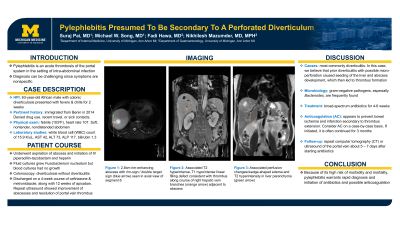Back


Poster Session A - Sunday Afternoon
Category: Liver
A0572 - Pylephlebitis Presumed to Be Secondary to a Perforated Diverticulum
Sunday, October 23, 2022
5:00 PM – 7:00 PM ET
Location: Crown Ballroom

Has Audio

Suraj Pai, MD
University of Michigan Medical Center
Ann Arbor, MI
Presenting Author(s)
Suraj Pai, MD1, Michael W. Song, MD1, Fadi Hawa, MD1, Nikhilesh Mazumder, MD, MPH2
1University of Michigan Medical Center, Ann Arbor, MI; 2University of Michigan, Ann Arbor, MI
Introduction: Pylephlebitis is acute thrombosis of the portal system in the setting of intraabdominal infection. Diagnosis is challenging since symptoms may be nonspecific, but early identification and management with broad spectrum antibiotics is essential. We present a case of pylephlebitis presumed to be secondary to a perforated diverticulum.
Case Description/Methods: A 63-year-old African American male with colonic diverticulosis presented with recurrent fevers and chills of two weeks duration. He immigrated from Benin 8 years ago but denied recent travel or sick contacts.
On presentation, patient was febrile to 103.1F with tachycardia (107 beats/minute). Physical examination was normal. Labs revealed leukocytosis (15.9 K/uL) and mildly elevated liver enzymes with hyperbilirubinemia (1.4 mg/dL). Abdominal imaging revealed two hepatic abscesses with a multifocal occlusive thrombus in the right hepatic vein and a nonocclusive thrombus in the right portal vein.
He underwent image guided aspiration of the abscesses and was started on intravenous (IV) antibiotics and heparin infusion. Fluid cultures grew Fusobacterium nucleatum and blood cultures had no growth. Due to concerns for colonic bacterial translocation, colonoscopy was performed which showed diffuse diverticulosis throughout the colon without evidence of diverticulitis. Upon clinical improvement, patient was discharged on a 4-week course of ceftriaxone/metronidazole with a 12-week course of apixaban. Repeat abdominal ultrasound a month after discharge showed interval improvement of hepatic abscesses and resolution of portal vein thrombus.
Discussion: Pylephlebitis is a rare condition but frequently associated with intra-abdominal infections, mainly diverticulitis which is the likely source in this patient. Inflammatory bowel disease and recent abdominal surgery have also been described as sources.
Diagnosis is established via imaging confirming portal vein thrombosis in setting of an intraabdominal infection. Gram-negative organisms are most commonly isolated. The mainstay of therapy is broad spectrum antibiotics for 4-6 weeks. The role of anticoagulation (AC) is controversial as robust evidence is lacking. However, it has been proposed that AC prevents bowel ischemia and infarction secondary to thrombus extension.
Despite the risk of sepsis and bowel infarction, morbidity and mortality rates have improved in recent years as imaging modalities have advanced and antibiotic options have diversified. AC should be considered on case-by-case basis.

Disclosures:
Suraj Pai, MD1, Michael W. Song, MD1, Fadi Hawa, MD1, Nikhilesh Mazumder, MD, MPH2. A0572 - Pylephlebitis Presumed to Be Secondary to a Perforated Diverticulum, ACG 2022 Annual Scientific Meeting Abstracts. Charlotte, NC: American College of Gastroenterology.
1University of Michigan Medical Center, Ann Arbor, MI; 2University of Michigan, Ann Arbor, MI
Introduction: Pylephlebitis is acute thrombosis of the portal system in the setting of intraabdominal infection. Diagnosis is challenging since symptoms may be nonspecific, but early identification and management with broad spectrum antibiotics is essential. We present a case of pylephlebitis presumed to be secondary to a perforated diverticulum.
Case Description/Methods: A 63-year-old African American male with colonic diverticulosis presented with recurrent fevers and chills of two weeks duration. He immigrated from Benin 8 years ago but denied recent travel or sick contacts.
On presentation, patient was febrile to 103.1F with tachycardia (107 beats/minute). Physical examination was normal. Labs revealed leukocytosis (15.9 K/uL) and mildly elevated liver enzymes with hyperbilirubinemia (1.4 mg/dL). Abdominal imaging revealed two hepatic abscesses with a multifocal occlusive thrombus in the right hepatic vein and a nonocclusive thrombus in the right portal vein.
He underwent image guided aspiration of the abscesses and was started on intravenous (IV) antibiotics and heparin infusion. Fluid cultures grew Fusobacterium nucleatum and blood cultures had no growth. Due to concerns for colonic bacterial translocation, colonoscopy was performed which showed diffuse diverticulosis throughout the colon without evidence of diverticulitis. Upon clinical improvement, patient was discharged on a 4-week course of ceftriaxone/metronidazole with a 12-week course of apixaban. Repeat abdominal ultrasound a month after discharge showed interval improvement of hepatic abscesses and resolution of portal vein thrombus.
Discussion: Pylephlebitis is a rare condition but frequently associated with intra-abdominal infections, mainly diverticulitis which is the likely source in this patient. Inflammatory bowel disease and recent abdominal surgery have also been described as sources.
Diagnosis is established via imaging confirming portal vein thrombosis in setting of an intraabdominal infection. Gram-negative organisms are most commonly isolated. The mainstay of therapy is broad spectrum antibiotics for 4-6 weeks. The role of anticoagulation (AC) is controversial as robust evidence is lacking. However, it has been proposed that AC prevents bowel ischemia and infarction secondary to thrombus extension.
Despite the risk of sepsis and bowel infarction, morbidity and mortality rates have improved in recent years as imaging modalities have advanced and antibiotic options have diversified. AC should be considered on case-by-case basis.

Figure: Figure 1: A) 2.8 cm rim-enhancing abscess with rim-sign/double target sign (blue arrow) seen in axial view of segment 8; B) Associated T2 hyperintense, T1 hypointense linear filling defect consistent with thrombus along course of right hepatic vein branches (orange arrow) adjacent to abscess; C) Associated perfusional changes/wedge-shaped edema and T2 hyperintensity in liver parenchyma (green arrow)
Disclosures:
Suraj Pai indicated no relevant financial relationships.
Michael Song indicated no relevant financial relationships.
Fadi Hawa indicated no relevant financial relationships.
Nikhilesh Mazumder indicated no relevant financial relationships.
Suraj Pai, MD1, Michael W. Song, MD1, Fadi Hawa, MD1, Nikhilesh Mazumder, MD, MPH2. A0572 - Pylephlebitis Presumed to Be Secondary to a Perforated Diverticulum, ACG 2022 Annual Scientific Meeting Abstracts. Charlotte, NC: American College of Gastroenterology.
